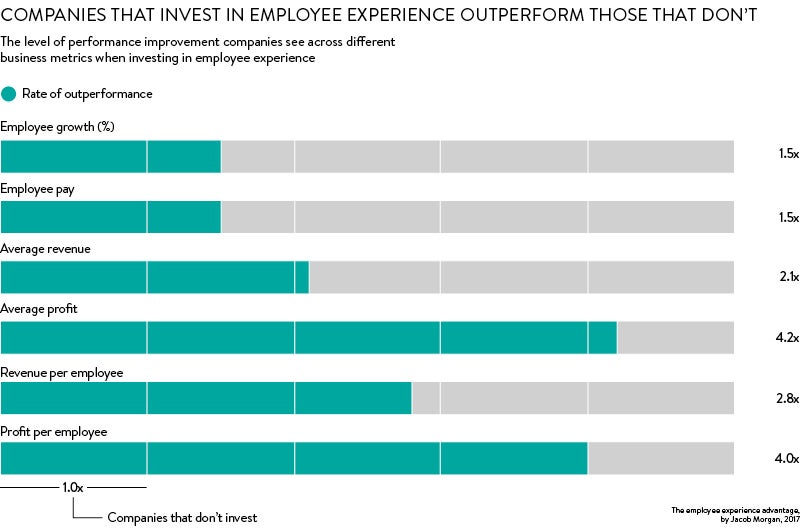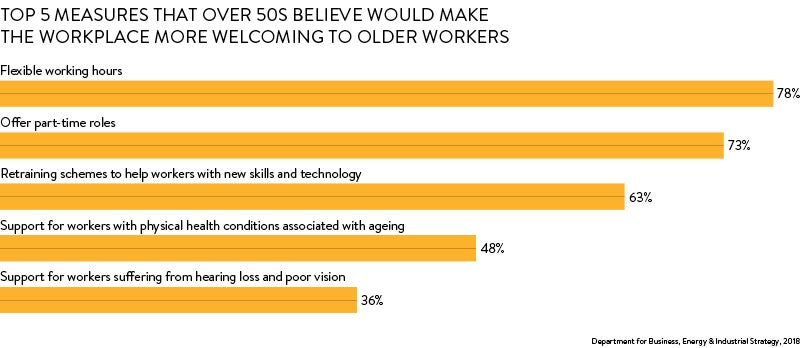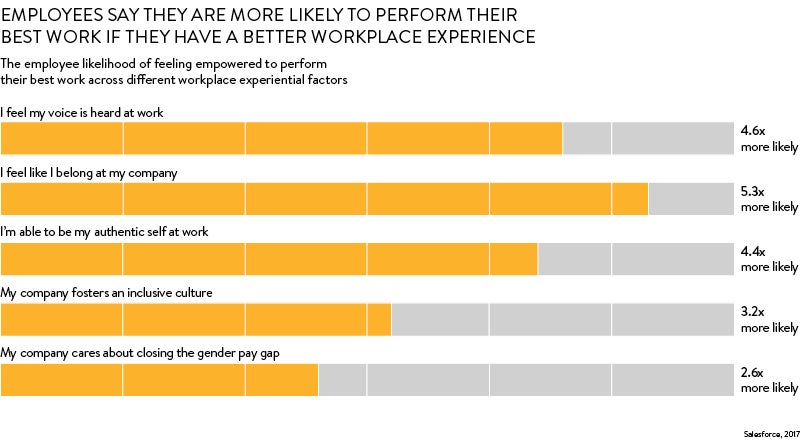The future of employee experience is changing and with it so is the employer-employee psychological contract. Pay and perks, traditional workplace satisfaction factors, are being swept aside. Employee engagement now requires an experiential component too.
These are the ways different touch points, whether physical, technological, cultural or environmental, are perceived by staff throughout their entire employee life cycle. These components are now regarded as essential building blocks for creating an all-important measure of employee experience (EX).
A buzz-phrase this is not. Getting the day-to-day mechanics of working for a company right makes business sense. Data reveals firms that invest in EX are four times more profitable, perhaps because they create happier, more engaged staff who can be up to 20 per cent more productive, according to Social Market Foundation research.
But how can HR leaders set about improving their employees’ experience? Here are nine ways to improve engagement and the future of your employee experience programme:
- Improve diversity and inclusion
- Refine the onboarding experience
- Introduce hyper-personalisation
- Embrace fluid and flexible work ecosystems
- Understand the convergence of CX and EX
- Adopt agile HR
- Use workforce analytics to measure and optimise
- Increase communication
- Employ technology as an enabler for younger and older employees alike
1. Improve diversity and inclusion
New research from non-profit gender diversity accelerator Catalyst finds almost half (45 per cent) of an employee’s experience of inclusion, such as feeling valued, trusted and psychologically safe at work, can be explained by their manager’s inclusive leadership behaviour.
“The business case around the benefits of a diverse workforce are now well known by most leaders, and diverse teams that are led inclusively will not only improve employee experience, but also provide a route to innovation and increased creativity, and directly improve client needs,” says Rukasana Bhaijee, senior manager for diversity and inclusion (D&I), people advisory services, at EY.
“When all individuals are included and feel a sense of belonging to an organisation this will result in higher motivation, stronger physical and mental wellbeing, and better performance and career outcomes.”
Diverse teams that are led inclusively will not only improve employee experience, but also provide a route to innovation and increased creativity
But a new conversation is also needed, says Daniele Fiandaca, co-founder of culture change business Utopia. “Diversity and inclusion need to switch. Business should lead with inclusion to then foster diversity and improve the employee experience,” he says.
“This way everyone wins as everyone takes responsibility to actively seek D&I to enrich their work and their lives, rather than force it to meet a quota.”
Read more about how organisations can design their diversity and inclusion policies to improve employee experience.
2. Refine the onboarding experience
A sobering 20 per cent of all staff turnover occurs within the first 45 days of hiring, with 17 per cent of all new hires leaving within their first three months.
Poor onboarding experiences are now recognised as a frequent contributor to this, with data suggesting employees at firms with a structured onboarding programme are 58 per cent more likely to still be with their organisation after three years.
“It makes perfect sense,” says Andrea Pattico, former head of talent at Moneysupermarket and now chief people officer at MVF, which in 2018 was recognised at the Employee Experience Awards for how it recruits new people.
“We want people to ‘want’ to come to work, whether it’s by organising fun stuff like bake-offs, creating an annual ‘Learning Fest’ event or this year’s paid-for Ibiza weekend for staff, to showing them we have a specific plan for their personal development, such as introducing new management training.
“We think perfect onboarding is showing staff that when they join, we’ve thought of everything they need and we’ll help them develop.”
Read more about how to design great onboarding processes that improve employee experience.

3. Introduce hyper-personalisation
Personalising EX can be a key differentiator and make employees feel the workplace is responsive to them and reflective of their personal needs.
Google, Airbnb and Salesforce have all created dedicated chief happiness officer, global head of EX or vice president of employee success roles to ensure focus on the individual is maintained and it has paid off.
Employee satisfaction at Google rose by 37 per cent as a result of employee support initiatives, while research by the University of Warwick shows personalisation improves employee happiness at work, leading to a 12 per cent spike in productivity.
Discover how new technologies are helping HR to hyper- personalise employee experiences.
4. Embrace fluid and flexible work ecosystems
Few things impact the experience of working for an organisation than perceived obstacles or inflexibilities, such as the inability to work from home, do compressed working weeks or work remotely.
“Flexible and remote working is the expected norm in the digital age,” says Dave Grant, manager, customer success at Silicon Valley, video-conferencing giant Zoom. And it cuts across the generations too, with nearly three quarters (73 per cent) of workers over the age of 50 now saying they want flexibility too. Often this is driven by a need to incorporate elder care responsibilities into their work-life balance.

“Flexible working doesn’t have to be synonymous with home working,” says EY’s Ms Bhaijee. “More dynamic solutions such as virtual collaboration suites and local shared spaces can benefit employees, customers and partners, and contribute to a fulfilling employee experience.”
Read more about employee ecosystems.
5. Understand the convergence of CX and EX
Complaints to organisations from their customers are rising in virtually all sectors, with casework by the UK ombudsman alone up 84 per cent in the last five years, as consumers demand more of organisations before parting with their hard-earned cash. This wider customer experience (CX) expectation is now moving into organisations too, as employees demand the same sort of “service” be relayed to them.
Colin Ellis, author of Culture Fix: How to Create a Great Place to Work, explains how organisations can embrace the “consumerisation” of employees. “The best companies treat their staff as customers,” he says.
“They ask what type of desk they want, what type of office environment they want to work in, how they want to influence the company culture and how they can contribute to their own experience.”
The best companies treat their staff as customers
It’s no surprise that when 500 chief human resources officers were interviewed across 12 countries in 2018, 56 per cent said they expected to create a “consumerised” EX within three years.
Read more about the convergence of EX and CX.
6. Adopt agile HR
“People are communities at work, so processes and systems need to not get in the way of this,” says Derek Irvine, senior vice president at Workhuman, a human resources software company, who believes the only way to improve EX is for HR to be able to recognise the “moments that matter”.
Too many organisations put processes before people and this is a failing of HR’s inability to be agile, he says. But having agile HR is both a technological and mindset issue.
People are communities at work, so processes and systems need to not get in the way of this
Jenny Goulding, founder of consultancy Agile HR, says: “Companies might want to look at offering holiday in excess of the statutory minimum. One company we worked for introduced a policy of allowing employees to sell back holiday at 110 per cent, which offers them a great ‘cash-back’ benefit. But this benefit can only be offered when the resulting holiday balance is statutory minimum or above, so a system-wide look at how HR can be more agile is needed to allow this to even happen.”
Read more about agile HR and technology.
7. Use workforce analytics to measure and optimise
Workforce analytics alone won’t guarantee improvements in EX, but it can at least help HR pinpoint areas where the experience can be improved.
Artificial intelligence and sentiment analysis in employee engagement platforms, such as Glint, can already make judgments about the language used in engagement surveys to predict if employees are likely to leave in the next six to twelve months.
With this knowledge to hand, EX interventions can be made to turn this around, for instance by offering more training. Firms already using this analysis include DocuSign.
Laura Harding, EX specialist with SAP Qualtrics, a software company, believes more advanced technologies will help organisations to find deeper, and more human, insights into the feelings and opinions of employees.
“The result is both a more personal and more accurate understanding of the workforce,” she says. “If leaders use these real-time insights wisely, they can make meaningful changes within the organisation, improve the overall employee experience and deliver returns back to the business.”
If leaders use real-time insights wisely, they can make meaningful changes within the organisation
An example of this can be seen at Experian, which has used analytics to improve the workplace experience and reduce employee attrition by 2 to 3 per cent. Using models to look at more than 200 attributes, including team size and structure, it found having teams of more than 12 people affected individual experience and that this was a risk factor which needed to be addressed.
Find out more about how workforce analytics can increase HR’s value.
8. Increase communication
There’s little in life that can’t be improved with a bit more communication. So it should come as no surprise that communication is a key piece of the EX puzzle. Staff who are regularly involved in employee communications, and who feel listened to, report feeling more engaged and that their working experience is more worthwhile.
This is echoed in research from Salesforce, whose report The Impact of Equality and Values Driven Business found that employees who felt listened to are 4.6 times more likely to perform at their best.

Susy Roberts, executive coach and founder of people development consultancy Hunter Roberts, says: “Communication needs to be maintained on an ongoing basis, more akin to a coaching relationship, rather than periodic reviews or appraisals. Good communication is a two-way stream; people should be encouraged to share their thoughts and suggestions about their role and the processes they carry out.”
This is echoed by Stephanie Holmes, senior research associate at global talent search firm Wilbury Stratton, who believes that to improve EX, organisations must listen more and try to create a continuous feedback loop between employee voices and employer actions.
She says: “Good communication isn’t necessarily about changing the methods or tactics, but about altering the frequency and timing of when these tactics are used.”
Read more about how communication can enhance the employee experience.
9. Employ technology as an enabler for younger and older employees alike
Thanks to 4G, wifi and the increasing intuitiveness of consumer products, the whole experience of using technology at home is now effortless, even enjoyable. The same cannot be said for technology in the workplace.
A recent poll by cloud-based talent management software provider Conerstone Ondemand found UK workplaces are failing to supply the latest technologies to help their employees work better, with 34 per cent of staff dissatisfied with the technology available at work.
Given the ease with which employees are able to do their jobs is a vital part of their workplace experience, the finding that a further 12 per cent say HR departments don’t provide them with the technology they need to do their jobs is a damning one.
Technology should not be an inhibitor, but rather cut across generational divides as an enabler of great EX. Dr Joe Cainey, head of data science at employee engagement platform provider Peakon, concludes: “People don’t want to go to work to do a bad job, but what they do want is the support and technology they need to do their work and know where they are in their employee journey.”
Read more about how technology can support workforce.
1. Improve diversity and inclusion
2. Refine the onboarding experience

